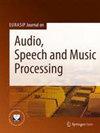使用 ResNet 检测音乐时间特征18
IF 1.9
3区 计算机科学
Q2 ACOUSTICS
Eurasip Journal on Audio Speech and Music Processing
Pub Date : 2024-06-13
DOI:10.1186/s13636-024-00346-6
引用次数: 0
摘要
时间特征检测是音乐信息检索的一项基本任务,有助于音乐的组织。近年来,音乐分析对稳健高效方法的需求日益增长,这凸显了时间特征检测技术进步的重要意义。在这项研究中,我们探讨了残差网络在时间特征检测中的有效性。此外,我们还将残差网络(ResNet18)的性能与音频相似性矩阵(ASM)和节拍相似性矩阵(BSM)等现有模型进行了比较。我们还将其与支持向量机 (SVM)、随机森林、K-近邻 (KNN)、天真贝叶斯等传统算法以及卷积神经网络 (CNN) 和卷积递归神经网络 (CRNN) 等深度学习模型进行了比较。评估是在 Meter2800 数据集上使用 Mel-frequency cepstral coefficients (MFCC) 作为特征表示进行的。结果表明,ResNet18 优于所有其他模型,从而显示了深度学习模型在准确检测时间特征方面的潜力。本文章由计算机程序翻译,如有差异,请以英文原文为准。
Music time signature detection using ResNet18
Time signature detection is a fundamental task in music information retrieval, aiding in music organization. In recent years, the demand for robust and efficient methods in music analysis has amplified, underscoring the significance of advancements in time signature detection. In this study, we explored the effectiveness of residual networks for time signature detection. Additionally, we compared the performance of the residual network (ResNet18) to already existing models such as audio similarity matrix (ASM) and beat similarity matrix (BSM). We also juxtaposed with traditional algorithms such as support vector machine (SVM), random forest, K-nearest neighbor (KNN), naive Bayes, and that of deep learning models, such as convolutional neural network (CNN) and convolutional recurrent neural network (CRNN). The evaluation is conducted using Mel-frequency cepstral coefficients (MFCCs) as feature representations on the Meter2800 dataset. Our results indicate that ResNet18 outperforms all other models thereby showing the potential of deep learning models for accurate time signature detection.
求助全文
通过发布文献求助,成功后即可免费获取论文全文。
去求助
来源期刊

Eurasip Journal on Audio Speech and Music Processing
ACOUSTICS-ENGINEERING, ELECTRICAL & ELECTRONIC
CiteScore
4.10
自引率
4.20%
发文量
0
审稿时长
12 months
期刊介绍:
The aim of “EURASIP Journal on Audio, Speech, and Music Processing” is to bring together researchers, scientists and engineers working on the theory and applications of the processing of various audio signals, with a specific focus on speech and music. EURASIP Journal on Audio, Speech, and Music Processing will be an interdisciplinary journal for the dissemination of all basic and applied aspects of speech communication and audio processes.
 求助内容:
求助内容: 应助结果提醒方式:
应助结果提醒方式:


